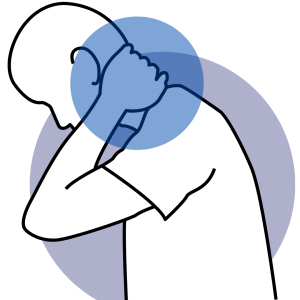
CERVICAL SPINAL CANAL STENOSIS
Cervical spinal canal stenosis is a narrowing of the spinal canal (vertebral canal or spinal canal). The spinal canal is a canal of bony structures containing the spinal cord and nerve roots. This narrowing can put pressure on the spinal cord and nerve roots, cause various symptoms and affect quality of life.
Spinal canal stenosis is often associated with the aging process. Compression of the discs between the vertebrae, bone spurs (osteophytes) in the joints, thickening of the ligaments in the spinal cord and other degenerative changes can lead to narrowing of the spinal canal over time. Although this condition is usually seen in the neck, it can also occur in the lumbar region.
CAUSES
Aging:
Disc compression, bone spurs and ligament thickening can increase with age.
Genetic Factors:
Genetic factors may play a role in people with a family history of spinal stenosis.
Spinal Deformities:
Spinal deformities such as scoliosis can narrow the spinal canal.
Spinal Trauma:
Lesions caused by accidents or injuries can narrow the spinal canal.
Calcification (Osteoarthritis):
Joint inflammation and bone spurs can be one of the causes of spinal stenosis.
SYMPTOMS
Pain Arising from the Neck:
Pain in the neck area can be caused by pinched nerve roots.
Pain and numbness in the arms:
Pressure on the spinal cord or nerve roots can cause pain, numbness and tingling in the arms.
Muscle Weakness:
Muscle weakness due to spinal cord compression, especially in the hands and arms.
Imbalance and Coordination Problems:
Spinal cord compression can lead to imbalance and coordination problems.
Difficulty Standing and Walking:
In severe cases, spinal cord compression can cause difficulty in standing and walking.
NON-SURGICAL TREATMENT OF CERVICAL SPINAL CANAL STENOSIS
Medication Therapy:
Painkillers, anti-inflammatory drugs and muscle relaxants can control pain and reduce inflammation.
Physical Therapy:
Physical therapy can be applied to strengthen the neck muscles, increase flexibility and correct posture. Muscle strength and flexibility can be improved with exercises recommended by physiotherapists.
Exercise Programs:
Special exercise programs that support and strengthen the neck area can improve the condition of the spine. Regular exercise can help strengthen muscles and increase flexibility.
Injection Therapies:
Steroid injections can help reduce inflammation and relieve pain by administering medication directly to the affected area.
Orthotics and Supportive Devices:
Neck collars or other supportive devices can reduce stress on the spine and help the patient achieve better posture.
SURGICAL TREATMENT METHODS IN CERVICAL SPINAL CANAL STENOSIS
Laminectomy:
A surgical procedure to remove bones, discs or tissues pressing on the spinal cord or nerve roots.
Foraminotomy:
A surgical procedure that involves widening the foraminal area that compresses the spinal nerve roots.
Discectomy:
A surgical intervention to remove calcified or herniated discs.
Cervical Fusion:
Fusion of the vertebrae, thus providing stability and reducing pressure on the spinal cord.
Artificial Disk Insertion:
A surgical procedure to preserve the mobility of the spine by removing the calcified disc and inserting an artificial disc.
Surgical treatments are usually considered in patients who do not respond to non-surgical methods or whose symptoms are severe. However, because each patient is different, the treatment plan should be customized to the individual situation. Treatment options are based on the patient’s overall health, lifestyle and the severity of their symptoms.




.png)
.png)
.png)